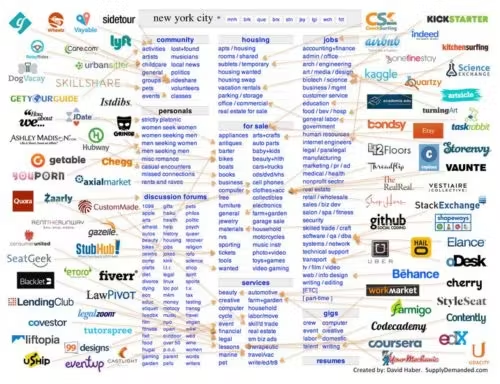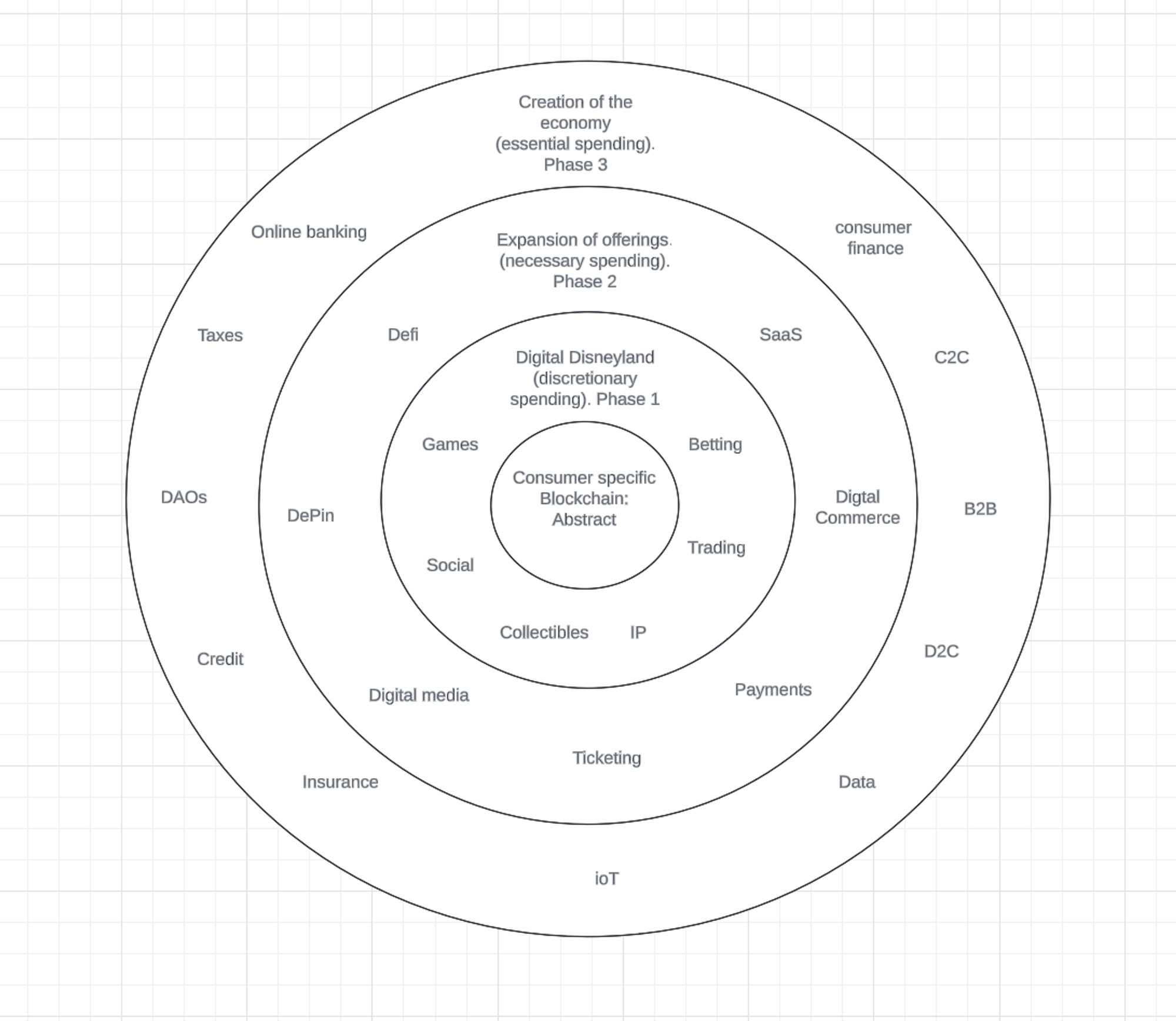Welcome to the 3rd episode of Consumer Notes, a newsletter covering the latest news and insights in consumer crypto.
In this episode, we cover the emergence of vertical blockchains, as an alternative form of general-purpose blockchains or app-specific chains. Vertical blockchains provides a concentrated venue with similar interest and characteristic, serving both for users and applications.
Below, you can also find the Roundup, which summarizes the major market news, along with our Curated Insights, featuring a curated selection of materials that offer valuable trends and insights into consumer crypto.
Don’t boil the ocean. When you’re number one, you create wonderful viral dynamics. Delighting your customers and being the leader in your category and geography, whatever those are, is very valuable.
By Fabrice Grinda
Until now, there have been primarily two types of blockchains: generalized blockchains and app-specific blockchains.
The majority of existing and pre-launched chains are general-purpose blockchains. These chains can support a wide variety of applications built on top of them, giving them the potential to become the largest hubs for most blockchain activities. However, these chains, especially newly launched ones, often struggle to differentiate themselves from others. While there still exists considerable room for improvements, the advantages that applications can gain from this advanced infrastructure often do not sufficiently compensate for the disadvantages of losing a significant user base and the composability between tokens and apps within a single chain. Furthermore, repeated launches and initiatives with negligible differentiation in the L1/L2 space have led to user and investor exhaustion, primarily benefiting only the farmers.
On the other end of the spectrum are app-specific blockchains. While ongoing experiments continue, few cases have been realized in practice. The limited adoption of app-chains may be attributed to their inability to provide a seamless user experience when exploring multiple applications. Additionally, running a full chain just to operate a single app seems inefficient to most builders in this space. While there are ongoing developments of frameworks that can mitigate these challenges for users and developers, it seems that it will take some time before these solutions are fully realized and implemented.

Source: Make your marketplace unit economics work
A promising and relatively unexplored alternative solution is the concept of purpose-built or vertical blockchains. While not entirely new, this idea has recently gained more prominence. Vertical blockchains resemble vertical platforms in Web2 businesses, a trend that often emerges as markets mature. While general platforms still generate most of the volume and user activities, but over time, more vertical platforms specializing in specific sectors or features tend to attract focused groups of users.
Vertical blockchains, tailored to specific sectors or functionalities, offer a seamless multi-app experience for users. These platforms host apps with similar characteristics, creating a focused ecosystem for specific user groups. Take, for example, the stark contrast between users trading memecoins and betting on internet trends, and those dealing with treasury bonds and yield optimization through platforms like Ethena and Pendle. By catering to each of distinct user bases, vertical blockchains eliminate the need for users to navigate between disparate ecosystems.
These specialized chains also leverage network effects to support their onboarded services, addressing the common 'cold start' challenge faced by new applications. For emerging apps, these platforms serve as effective distribution channels, providing direct access to their target audience and a stage to showcase their value proposition. Some chains go a step further, offering specialized tools and features that can significantly reduce initial setup costs and operational overheads for developers. This allows teams to channel their resources more efficiently, focusing primarily on service development and innovation.

Source: What is Consumer Crypto?
The most apparent, but not exhaustive examples in this theme are Abstract for consumer applications and Plume Network for RWA projects.
While Abstract is expected to offer special features and tools for use as a consumer chain, such as the Abstract Global Wallet (AGW), its true value may lie in serving as an integrated distribution channel and generating network effects through similarities in user demographics and application types. Despite uncertainties in its detailed strategy and features, Abstract appears to have the greatest chance of success among similar projects.
Unlike infrastructure innovations or B2B services, the success of consumer-facing crypto apps is far less predictable. This uncertainty stems from the volatile and often whimsical nature of user behavior and preferences, especially in a field where most services are designed to capture users' excitement and interest rather than fulfill a specific, tangible need.
The current crypto landscape, with its focus on user engagement and novelty, makes it particularly challenging to anticipate what will constitute an optimal user experience. In this circumstances, the key lies in creating an ecosystem that enables multiple positive EV plays, thereby increasing the overall probability of success.
Pudgy and Luca stand have demonstrated exceptional marketing and community-building skills in the crypto space, crafting viral campaigns that have built influential communities around their brands. Their success goes beyond mere attention-grabbing tactics; they've maintained consistent brand strategies and high-quality standards - crucial factors for long-term success in consumer applications. This level of commitment and skill is particularly rare in the crypto world, where many projects prioritize rapid progression to the next hype cycle.
Abstract seems to be positioning itself to capitalize on this dynamic. By leveraging superior community-building and marketing capabilities, they aim to attract a critical mass of target users to their platform. This user concentration, in turn, is likely to draw more talented developers into their ecosystem. The potential synergy between quality services and an engaged user base could significantly strengthen Abstract's position as a leading vertical blockchain for consumer applications.

Source: Plume
Another prominent candidate for vertical blockchain is Plume Network. Plume is a modular blockchain specifically designed to address the main challenges of the RWA, while creating a new sector called RWAfi. By directly integrating tokenization engines and regulatory compliance into its platform, Plume has significantly reduced the complexity of building RWA projects.
Plume is fostering a virtuous cycle that lowers entry barriers and attracts more assets and users to its ecosystem. Within the Plume ecosystem, users will be able to leverage tokenized real-world assets in ways similar to how they currently use other on-chain assets and protocols. This includes using RWAs as collateral for loans, staking for interest generation, borrowing against them, and even engaging in high-leverage speculation through derivative trading. By enabling these diverse activities centered around RWAs, Plume is not just tokenizing assets but creating a new financial ecosystem that blurs the lines between physical and digital assets.
Note that Abstract and Plume are not exhaustive in the field of vertical blockchains. An increasing number of chains are positioning themselves and attracting builders through focused operations, branding, and features. As the industry matures, we are witnessing the end of the era focused solely on building generalized chains. The next phase involves developing sector-focused platforms that can build network effects of concentrated users and applications with similar properties and interests.
Sofamon intorduces Gacha Machine, collaborating with CatizenAI
Metamask enables Mastercard debit card for instant spending directly from wallet
Story announces $140M in total fundraising to build the World’s IP Blockchain
Wizzwoods, a SocialFi pixel farming game on Berachain, is revealed
Interoperability, New Token Models, and the State of Funding with Jarrod Dicker of TCG Crypto
[E2] 2년만에 기업가치 3조원 | 최연소 구글 딥마인드 PM이 크립토로 뛰어든 이유 | 스토리 프로토콜 Story Protocol | Jason Zhao
The Evolution of Online Speculation & Prediction Markets with the Founder of FanDuel